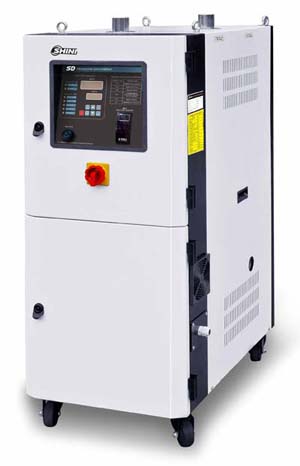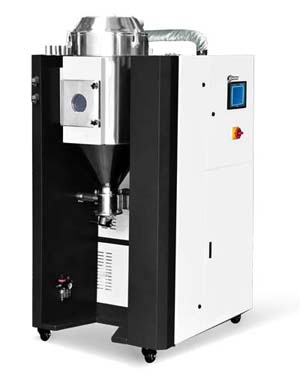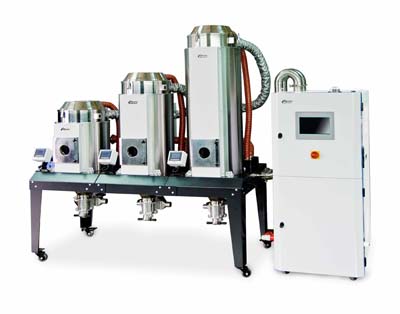Special Reports
Application of Energy-saving Technology in Drying and Dehumidifying Equipment
Energy-saving technology uses the advanced technology to reach the energy-saving purpose.In details, it according to energy consumption, consumption type to analyze the consumption status, and find out the potential saving point of the wasted energy. Then, take corresponding measures to cut down the waste of energy consumption, which achieves the purpose of energy saving.
In the process of plastic molding, energy consumption of electricity takes up a large part of the total amount, which directly affects the profit margins of plastic molding processing enterprises. For a complete set of molding production line, the most energy consumption equipment usually is the molding machine, energy consumption of auxiliary equipment generally accounts for ratio of 10%~30%. For large PET production line, the energy consumption occupies larger proportion. Regarding to energy consumption of auxiliary equipment, the main machine is the drying and dehumidifying equipment, which usually takes up 50% of the total amount. So how to improve the utilization rate of energy in drying and dehumidifying equipment is crucially important for energy saving. Following is the introduction of energy-saving technologies commonly used in drying and dehumidifying equipment.
Dew-point Temperature Control Technology
For most high hygroscopic plastic materials, such asPET,PAetc., traditional hot dying air only could get rid of the moisture on plastic material surface, which can’t efficiently eliminate the moisture inside the materials. Consequently, it can’t properly satisfy the requirements of the pre-drying, and results products molding in poor quality, various defects as contamination, scorching etc. So, in actual production process, the dehumidifier needs collocating with the hot air dryer to reach the optimum drying effect. In dehumidifier model selection, the most important parameter is the lowest dew-point temperature formed by airflow and dehumidifier. Dew point is the index of air dryness, it indicates the moisture content of the air. The lower the dew point, the less the moisture content and the dryer of the air. Currently, the majority of drying dehumidifiers used in plastic materials on the market all adopted the honeycomb rotors. The lowest dew-point could reach-30℃or above, which could satisfy more than 95% of the drying requirements. But the reachable lowest dew point temperature is nonadjustable. No matter what kind of material, for the drying, the dew point temperature would be maintained. However, some materials could also reach the drying requirements with no need for such a low dew point temperature. If the dew point is kept at the best statue all the time, power consumption of the regenerative heater would increase. It is well-known that the dew-point temperature has a close relationship with the regeneration temperature of honeycomb rotor. By control of dew point temperature, could make it comply with the regeneration temperature of honeycomb rotor, finally achieves the energy-saving purpose for the regenerative heater. That is the dew-point temperature control technology.
Drying Airflow Auto-control Technology
As it mentioned, the dehumidifying airflow plays an important role in the drying process. Reasonable airflow enables optimal drying effect and optimizes the energy consumption. For different materials, the requiring drying airflow is also different. If the material doesn’t need dehumidifier fully provided airflow that can finish the drying process, cut down the working time of the drying heater to appropriately control the air flow is available. As long as it supplies proper drying airflow for the material, which not only reaches the drying purpose, but also achieves the energy-saving effect as well.
There are mainly two kinds of the auto-control technologies for drying airflow, the open loop control and the closed loop control. Airflow, in open loop control, is according to the order from control system to auto-process the adjustment. Generally, it can be achieved by frequency-converter control with blower rotational speed. However, final output airflow without effective test which is unable to ensure whether it meets the requiring amount or not. The advantage of this control method lies in cost control and could meet auto control required air volume, which is suitable for one-to-one drying and dehumidifying system. Based on open loop control, the closed loop control added the feedback process. In real-time test the airflow entered the drying hopper, then transmit the value to control system to compare with the set value, which could process real-time adjust the blower exhausting airflow, and meet output accuracy. The advantage of this control method lies in accuracy control, but costs more than the former one, which is suitable for airflow auto-distribution in one-to-multi drying and dehumidifying system. Both the two controls are all according to the material characteristics and throughput to complete auto calculation and airflow control.
Heat Insulation Technology
Heat insulation technology has a long history, it has been a very mature and low-cost technology in energy saving filed till now, and has applied in various aspects in the society. Heat insulation is also be noted as the fifth energy, the improvement of this technology standard is a effective technical measure for enterprise energy-saving, costs reduction and profits increasing.
For drying and dehumidifying equipment, the gathering and maintaining of the temperature is mainly guaranteed by external protection structure. The drying hopper is the main body of the external structure, which plays a major role. Therefore, the reasonable design of the heat-insulation structure for the drying hopper is crucial.
Heat insulation structure usually consists of heat-insulation layer and the protective layer, the key point of good heat-insulation is to select suitable material and economic insulation thickness. The thickness of heat-insulation layer can be ensured by economic thickness method, which is divided into two kinds of physical models, the flat wall and the pipeline. When the external diameter of the pipeline and the equipment is larger than1,020mm, the layer thickness could be calculated by the flat wall model. The selection of insulation material generally needs to considerate heat conductivity coefficient, applicable temperature range and fireproof performance etc. Heat conductivity coefficient is a coefficient that stands for the heat transmission capacity of the insulation material, in unit of w/(m.K). The smaller the coefficient, the better the insulation performance. The applicable temperature range indicates that different material has different temperature applicable range, so we should pay special attention during selection. For example, as the heat-resistance degree of the polystyrene foamed plastics could only reach80℃, it could not be used in thermal engineering. Fireproof performance denotes the flame resistance, which is commonly expressed by oxygen index. The larger the value, the better the flame resistant property.
Heat Recycling Technology
Heat insulation technology is a passive energy saving method, while heat recycling technology is much more progressive. It is an active energy saving method, which via the recycling of wasted heat to reach energy saving effect. For drying and dehumidifying equipment with honeycomb rotor, the regeneration temperature of the honeycomb rotor needs to be maintained at certain interval to provide drying air. Thus, the heat loss of regeneration loop is constant, the air outlet discharging temperature is 30~60℃higher than the environment temperature. Effectively pre-heat the inlet air by this part of heat reduces heat regeneration time and saves energy consumption.
Heating Power Adjustment Technology
Temperature controller on the basis of actual temperature value, after internal calculation, outputs the current analog signal or voltage analog signal to power adjuster. The silicon-controlled power adjuster adjusts the heating power of the heater to control the heating quantity of the system. When heating system temperature is much lower than the set value, the silicon controlled outputs the full power, the heater is at full power working state. When heating system temperature is close to the set value, the silicon controlled output power would be getting less and less. Once the temperature arrive the set value, the silicon controlled output power is 0. By power to control the heating, one side it saves energy; at another side it possesses highly temperature control accuracy and reliability. Temperature control system that adopted the power control heating costs more than the traditional control method.
Above all, various kinds of energy saving technologies have already applied in Shini drying and dehumidifying equipment. Heat insulation technology is the standard function; dew-point control function, drying airflow auto-control technology and heat recycling technology are the optional functions; heating power adjustment technology is customized.
Model selection of SD-H Honeycomb Dehumidifier, SDD Dehumidifying Dryer and "All-in-One" Compact Dryer is according to below specifications.
Energy-saving models add “ES” at the end of the model code. It contains drying airflow auto-control function and regenerative heat recycling device, standard equipped with touch control HMI, which maximumly saves 41% of the total power. Material hourly dosage can be set between 40~100% of the rated drying capacity, drying airflow can be auto adjusted, the total power consumption saves 35%~0; Adopt the regenerative heat recycling device, regeneration suction via plate exchanger to recycle the heat exhausted from regeneration, which saves 3%~6% of the total power.
If it is optional with the dew-point control, add “DC” at the end of the model code. Simultaneously, it needs to option with ES, by setting of the dew-point temperature to auto-control the regeneration required temperature, lower the power consumption of the regenerative heater. As the set dew point temperature between-40℃~+10℃, total power consumption could save 0~10%.



Smart Modular Dehumidifying Dyer SSMD-U adopts drying airflow auto-control technology with closed loop, which according the material to choose modular drying hopper in different capacity to assemble the “One-to-Multi” Dehumidifying Dryer. Control system on the basis of material and usage amount in every dying hopper to auto-distribute the drying air to each drying hopper precisely, which reaches the proper drying and saves energy as well.

Special Reports
- Principle and Application of Pneumatic Conveying Technology
- System Sales Engineering Department of Shini (Dongguan) Established
- Standard Swing-arm Robot 1
- Shini Germany Attended the 2015 German Fakuma
If you want to read other articles, back to2016 Quarter 1 Issue 26.
